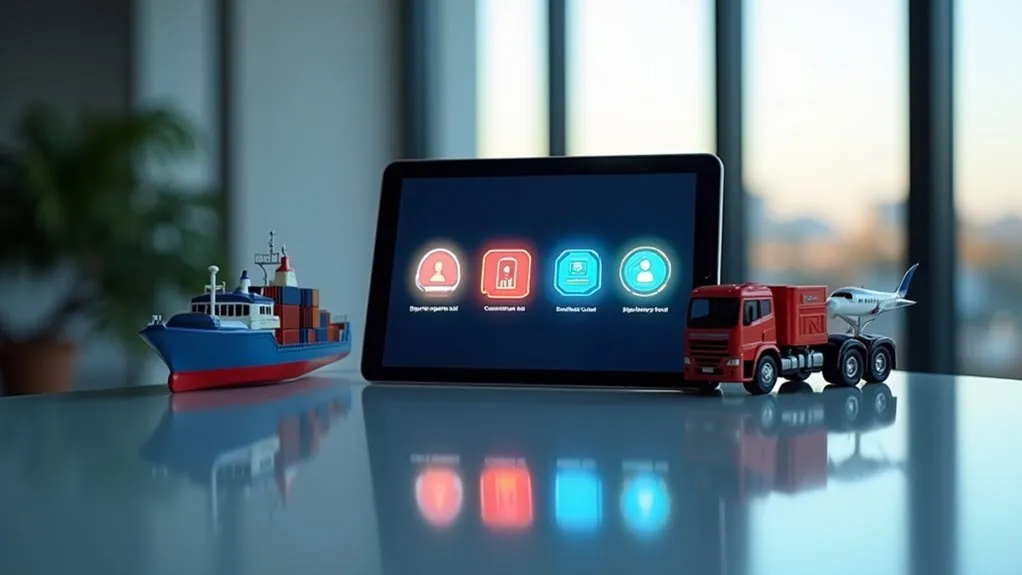Hapag-Lloyd’s Track and Trace system provides a precise five-step process to monitor shipments. First, gather essential details like B/L Number, Container Number, or Booking Reference. Next, access the Online Business Suite or mobile app for tracking. Then, enter the identifiers in the “Track” section. Review real-time status updates on key milestones like vessel departure. Finally, set up notifications for event alerts. Explore further to uncover detailed insights on shipment management.
Key Takeaways
- Gather shipment details like B/L Number, Container Number, or Booking Reference for accurate tracking.
- Access Hapag-Lloyd’s Online Business Suite or mobile app for real-time tracking.
- Enter the identifier in the “Track” section and click “Track Shipment.”
- Review shipment status for updates on milestones like vessel departure or discharge.
- Set up notifications for event alerts or reefer temperature deviations via email or API.
Gather Your Shipment Details

Begin by collecting the essential shipment identifiers required for Hapag-Lloyd’s tracking system. The primary identifiers include the Bill of Lading (B/L) Number, Container Number, and Booking Reference Number, each serving as a critical input for precise tracking. The B/L Number, often prefixed with “HLCU” or “HL” followed by 8-12 alphanumeric characters, acts as proof of cargo delivery. Container Numbers, such as HLCU1234567, feature prefixes like HLBU or UACU, denoting ownership. The Booking Reference Number, assigned during booking creation, links all containers in a shipment. This unique number also enables end-to-end visibility on platforms like Visiwise for comprehensive tracking.
Ensuring Identifier Accuracy is paramount to avoid tracking errors. These details are typically found on various Document Types, including shipping confirmations, bills of lading, or booking records provided by the sender or freight forwarder. Carefully verify each identifier against the original documents to confirm correctness. Thorough preparation of these details guarantees accurate monitoring of shipment status and movements through Hapag-Lloyd’s system.
Access the Tracking Platform
How can one efficiently monitor a shipment with Hapag-Lloyd? Accessing the tracking platform is a critical step, and Hapag-Lloyd offers multiple precise avenues for this purpose. Users can connect through the official website by navigating to the “Online Business Suite” and selecting the “Tracking” option, ensuring global reach with internet availability. Options like Mobile Access further enhance convenience, allowing real-time updates via dedicated apps or responsive web interfaces.
Hapag-Lloyd simplifies shipment monitoring through its Online Business Suite and mobile access, offering real-time updates with global internet connectivity.
For a structured approach to platform access, consider the following technical pathways:
- Website Portal: Access the primary tracking section on Hapag-Lloyd’s site for instant transport data.
- Third-Party Platforms: Utilize logistics tools like ShipsGo for consolidated tracking features.
- Mobile Access: Leverage mobile-friendly interfaces for on-the-go monitoring.
- API Integration: Integrate tracking via Hapag-Lloyd’s API, adhering to DCSA standards for automated data retrieval.
These methods ensure robust, tailored access to shipment visibility with technical precision.
Enter the Required Information

Accessing shipment details on Hapag-Lloyd’s tracking platform requires users to input specific identifiers into the designated search field. This field, prominently located on the “Track” section under “Live Position,” accepts primary identifiers such as the Booking Number, Container Number, or Bill of Lading (B/L) Number. These alphanumeric codes—unique to each shipment aspect—must be entered accurately to initiate tracking.
Regarding Input Methods, users can obtain these identifiers from shipping documents, invoices, or directly from the shipper. The chosen number is typed or pasted into the search bar, followed by clicking “Track” or “Track Shipment.” For Validation Tips, ensure the correct format is used; for instance, B/L numbers often begin with “HL” or a SCAC code like “HLCU,” while Container Numbers follow specific alphanumeric patterns. Double-checking the entered data against original documents prevents errors, ensuring the system processes the request efficiently and retrieves the correct shipment information.
Review the Shipment Status
Upon entering the correct identifiers into Hapag-Lloyd’s tracking platform, users can promptly access a comprehensive overview of their shipment’s status. This detailed interface facilitates Status Analysis by presenting real-time updates on the shipment’s current stage, from gate-in to discharge, alongside precise event timestamps to track progress and anticipate arrival times.
For a thorough Milestone Review, the platform offers critical insights into container movements. Key milestones include:
- Gate Out (Full): Indicates the container has departed the origin terminal.
- Loaded on Vessel: Confirms the container is onboard, with vessel name and voyage number visible.
- Vessel Departure: Marks the ship’s sailing from the origin port.
- Discharged: Verifies the container has been unloaded at the destination.
Users can also access transport plans, estimated departure and arrival times, and related documents. This technical depth ensures accurate monitoring of shipments, enabling precise logistical planning through systematic status evaluation.
Set Up Notifications for Updates

Why settle for manual tracking when automated updates can streamline the process? With Hapag-Lloyd’s tracking tools, users can configure notifications to stay informed on shipment status without constant manual checks. The system offers diverse Notification Types, including email alerts for container events, near real-time updates via Hapag-Lloyd LIVE for reefer temperature deviations, and API-driven push notifications for location data every 15 minutes inland or 24 hours on ocean legs.
Alert Customization is robust, allowing users to tailor settings for specific parameters like atmosphere (O2/CO2) or milestones via third-party platforms like ShipsGo. Notifications can be received through email, Slack, or WhatsApp. Below is a snapshot of notification options:
| Platform | Notification Type | Customization Feature |
|---|---|---|
| Hapag-Lloyd Standard | Email Alerts | Event-based Triggers |
| Hapag-Lloyd LIVE | Reefer Monitoring | Temperature/Atmosphere Alerts |
| Third-Party (ShipsGo) | Milestone Updates | Custom Milestones |
| API Integration | Real-Time Location | Geofencing Alerts |
This enhances supply chain visibility and proactive planning.

 Tiếng Việt
Tiếng Việt 日本語
日本語 中文 (中国)
中文 (中国) 한국어
한국어
